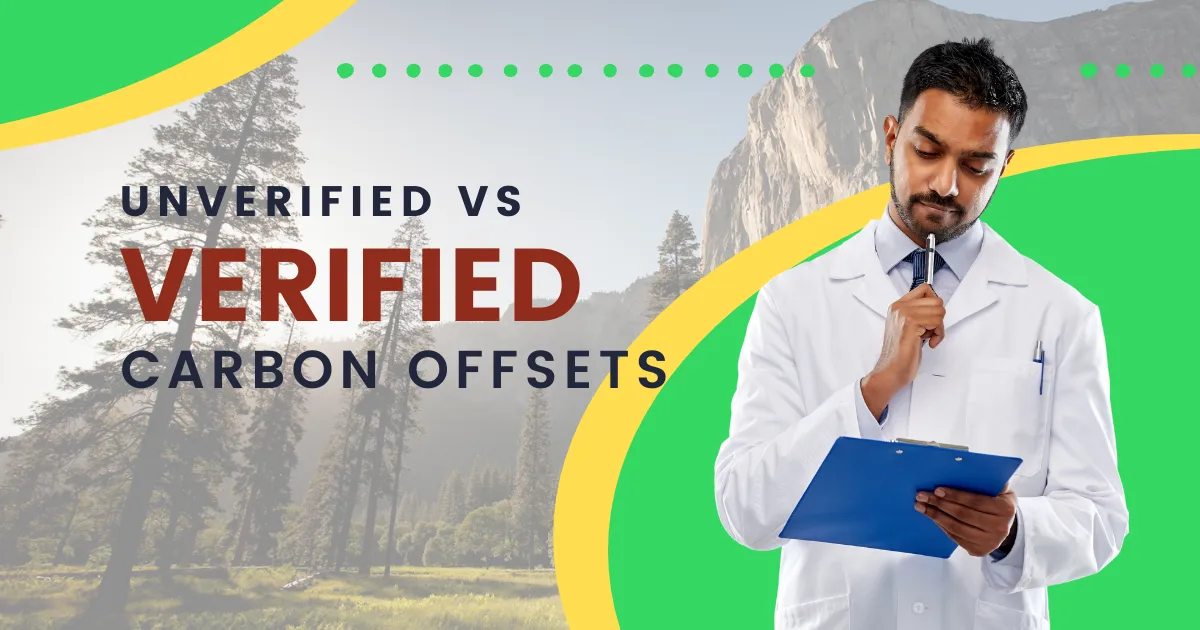Alright, let’s dive into the world of carbon offsets, focusing on the difference between unverified and verified carbon offsets. This is a topic that’s both incredibly relevant and a tad complex, given the urgency of our global climate crisis and the rising interest in sustainable solutions.
Understanding Carbon Offsets
First off, carbon offsets are a key tool in the fight against climate change. They work by allowing individuals and businesses to invest in environmental projects around the world to balance out their own carbon footprints. These projects can range from plant-based carbon sequestration to reforestation to direct air capture (DAC) to renewable energy initiatives. However, not all carbon offsets are created equal, which brings us to the distinction between unverified and verified carbon offsets.
Verified Carbon Offsets
Verified carbon offsets are the gold standard in the world of carbon offsetting. These offsets have undergone rigorous assessment and validation by third-party organizations to ensure that they meet specific environmental standards and truly contribute to carbon reduction. Verification bodies, such as the Verified Carbon Standard (VCS) and Climate Action Reserve, set these standards.
The verification process involves a detailed review of the project’s methodology, implementation, and actual impact. It ensures that the project delivers the promised environmental benefits, follows best practices, and contributes to sustainable development goals. Verified projects are transparent, and their results are publicly available, providing buyers with confidence that their investment is indeed making a difference.
Unverified Carbon Offsets
Unverified carbon offsets, on the other hand, have not gone through such a stringent verification process. While they may claim to contribute to carbon reduction, there is no independent third party confirming these claims. This lack of oversight can lead to issues such as double counting (where the same carbon reduction is sold to multiple buyers), projects that would have happened anyway (lacking in additionality), or even fraudulent projects.
Unverified offsets often appear cheaper and more accessible, but they carry a higher risk of not providing the environmental benefits they claim. This uncertainty undermines the credibility of carbon offsetting as a tool for combating climate change and can lead to skepticism among potential buyers.
Why Verification Matters
The difference between verified and unverified carbon offsets isn’t just a matter of paperwork; it’s about integrity, transparency, and real impact. Verified offsets ensure that your investment is actually contributing to carbon reduction, supports projects that are environmentally and socially beneficial, and helps to promote a global shift towards sustainability.
Moreover, as the demand for corporate responsibility and environmental sustainability grows, verified carbon offsets have become a critical part of companies’ sustainability strategies. They provide a tangible way for businesses to demonstrate their commitment to combating climate change, enhancing their brand reputation, and engaging with environmentally conscious consumers.
Choosing the Right Offset
For individuals and businesses looking to offset their carbon emissions, the choice between verified and unverified offsets is clear. Verified offsets offer transparency, reliability, and the assurance that your investment is making a real difference. While they may come at a higher cost, the value they provide in terms of environmental integrity and project effectiveness is unparalleled.
When selecting a carbon offset project to invest in, consider the following:
- Certification: Look for projects certified by reputable standards like VCS or Climate Action Reserve.
- Transparency: Ensure the project provides detailed information about its methodology, implementation, and results.
- Impact: Choose projects that not only reduce carbon emissions but also contribute to biodiversity, community development, and other sustainable development goals.
The Risks of Unverified Offsets
Investing in unverified carbon offsets carries not just the risk of minimal environmental impact, but also the potential for significant reputational damage. When companies are exposed for backing fraudulent or ineffective projects, the embarrassment is public and damaging. This scenario not only undermines a company’s environmental claims but can also erode trust among customers, investors, and partners. In today’s digital age, news of such missteps spreads quickly, magnifying the negative impact on a company’s image. Moreover, the financial implications of investing in such projects can be considerable, from sunk costs in the offsets themselves to potential losses in customer base and stock value. Therefore, conducting due diligence before investing in carbon offsets is not just about ensuring environmental impact but also about safeguarding against reputational risk. Choosing verified carbon offsets is a step towards ensuring that environmental efforts are genuine, impactful, and above all, credible in the public eye.
The Bigger Picture
While carbon offsets are a valuable tool in our sustainability toolkit, they are not a silver bullet for climate change. They should be part of a broader strategy that includes direct efforts to reduce emissions through energy efficiency, renewable energy, and sustainable practices.
The distinction between unverified and verified carbon offsets is critical in ensuring the effectiveness and integrity of carbon offsetting as a tool for climate action. By opting for verified offsets, we can support genuine environmental projects, contribute to global sustainability goals, and take meaningful steps towards mitigating climate change. Let’s make our contributions count.
As you consider your next steps towards environmental stewardship, let Dynamic Carbon Credits be your guide. We specialize in navigating the complexities of carbon credit solutions, helping businesses not just to minimize their carbon footprint but to offset it in a meaningful way. Our collaboration with leading companies involves a comprehensive approach: from accurately measuring emissions to crafting tailored reduction strategies, and finally, compensating for unavoidable emissions with verified carbon credits or natural solutions. Our dedication lies in ensuring that your contributions are invested in local, certified projects, promising substantial and positive environmental outcomes. With Dynamic Carbon Credits, your journey toward genuine environmental responsibility is both clear and impactful.





